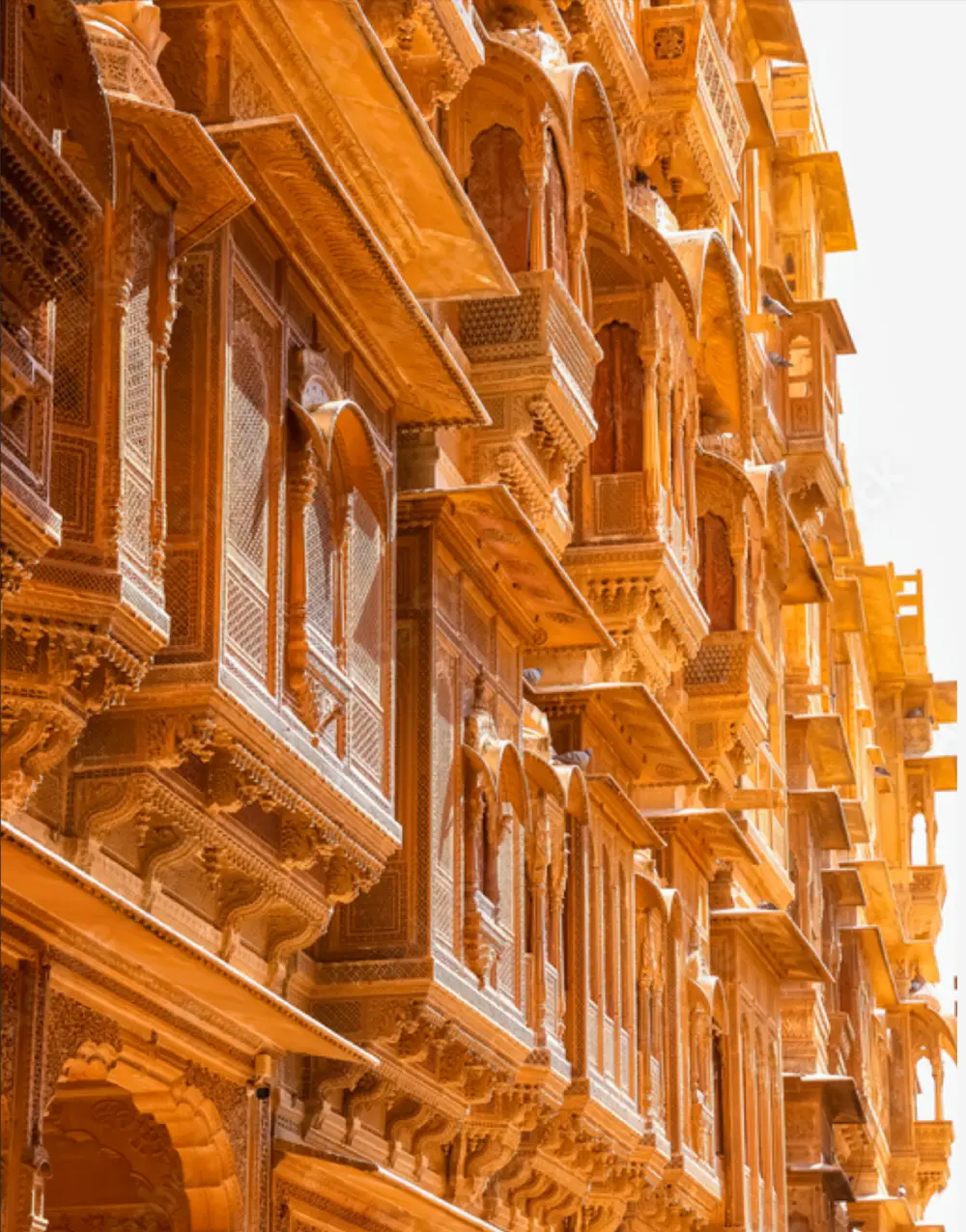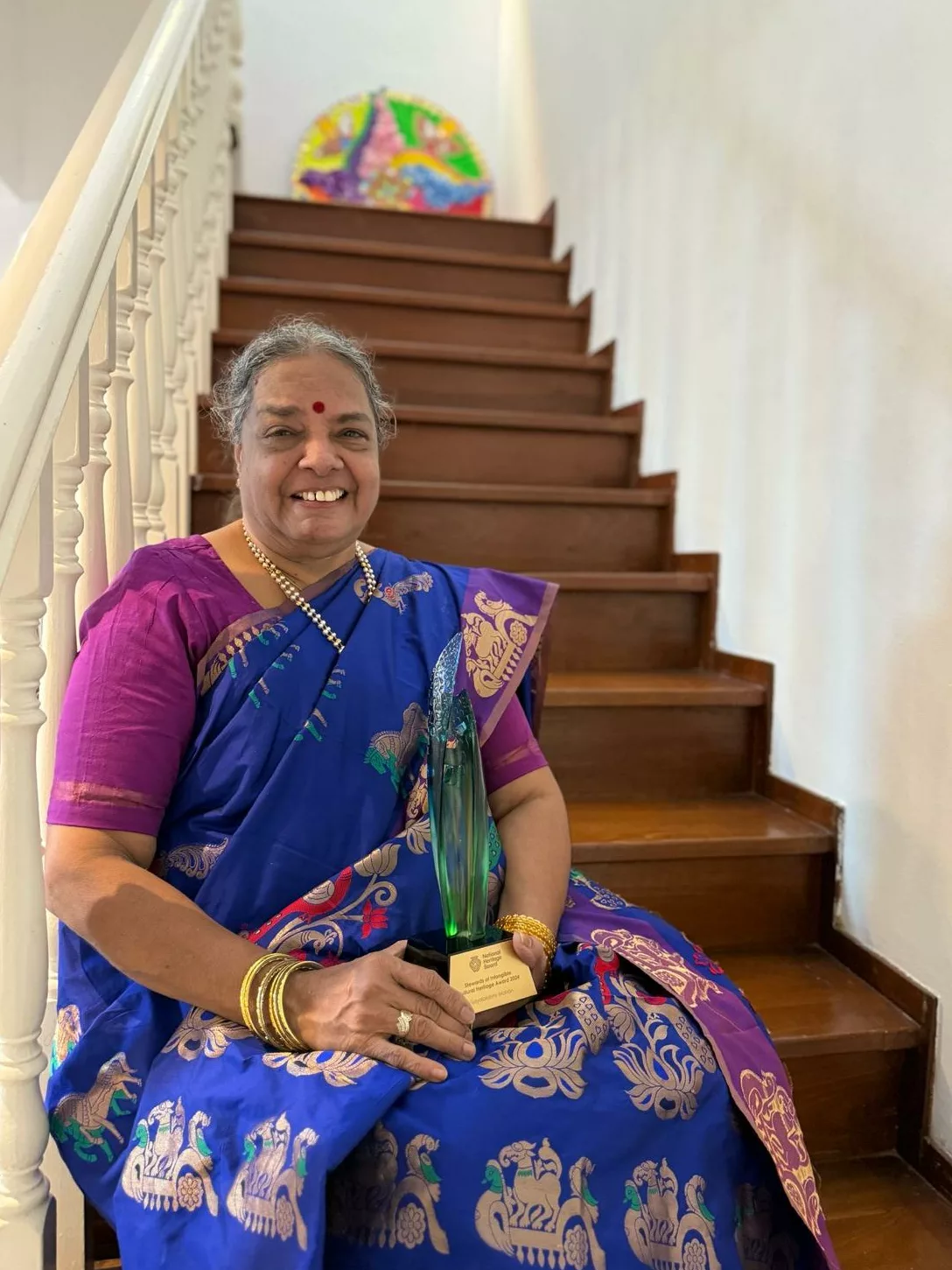
Art transcends boundaries — seldom has this saying proven truer than in the life of Vijayalakshmi Mohan, renowned Indian-origin Singaporean rangoli artist and art therapist, and one of the five recipients this year of the Stewards of Intangible Cultural Heritage Award, presented by the National Heritage Board (NHB) of Singapore.
Speaking to Himanshu Verma and Sanchita Guha, representing Connected to India, about this honour and how she has shared her talent with Singapore, she says, “I have been doing rangoli for the past 60 years and I have done a lot of work in Singapore. After my Guinness World Record [for the largest rangoli], I have created more than 50 Singapore records [in rangoli], involving multi-racial Singaporean people from the age of 3 years to 93 years.”
Indians, regardless of rural or urban backgrounds, know what rangoli is and most women have tried their hand at this artistic pursuit at least once in their lifetime.
The vibrant rangoli, made with coloured powders and frequently seen across North India, has its counterparts in the white kolam, made with rice flour, in South India; or in the white alpana, made with rice flour or chalk paste, in East India.
As Indian people have moved around, rangoli and kolam and alpana have also travelled around regions within India and have been carried overseas by the Indian diaspora.
These beautiful and symmetrical designs, made on the floor, mark special occasions, such as religious festivities or a wedding or a housewarming, and are an expression of the everyday creativity in Indian culture.
Over the past several decades, Vijayalakshmi Mohan, now aged 66, has been introducing people in Singapore and other countries to this art form. In Singapore, she has turned the rangoli into a vehicle of cross-cultural communication.
In August 2023, Vijayalakshmi received the “Long Service Award” — a medal and a certificate of appreciation — from Edwin Tong, Singapore Minister for Culture, Community and Youth and Deputy Chairman of the People’s Association, for rendering “Twenty Years of Dedicated Voluntary Service to the Community”.
Not only Indians [but also] all the other races [in Singapore] have taken part in creating rangoli with me. So, I feel proud and I feel honoured to receive this [NHB] award, because my work is recognised. My efforts — whatever challenges I have faced, whatever initiatives I have taken — are recognised and honoured. I feel so happy about it.
Vijayalakshmi Mohan, rangoli and kolam artist and art therapist
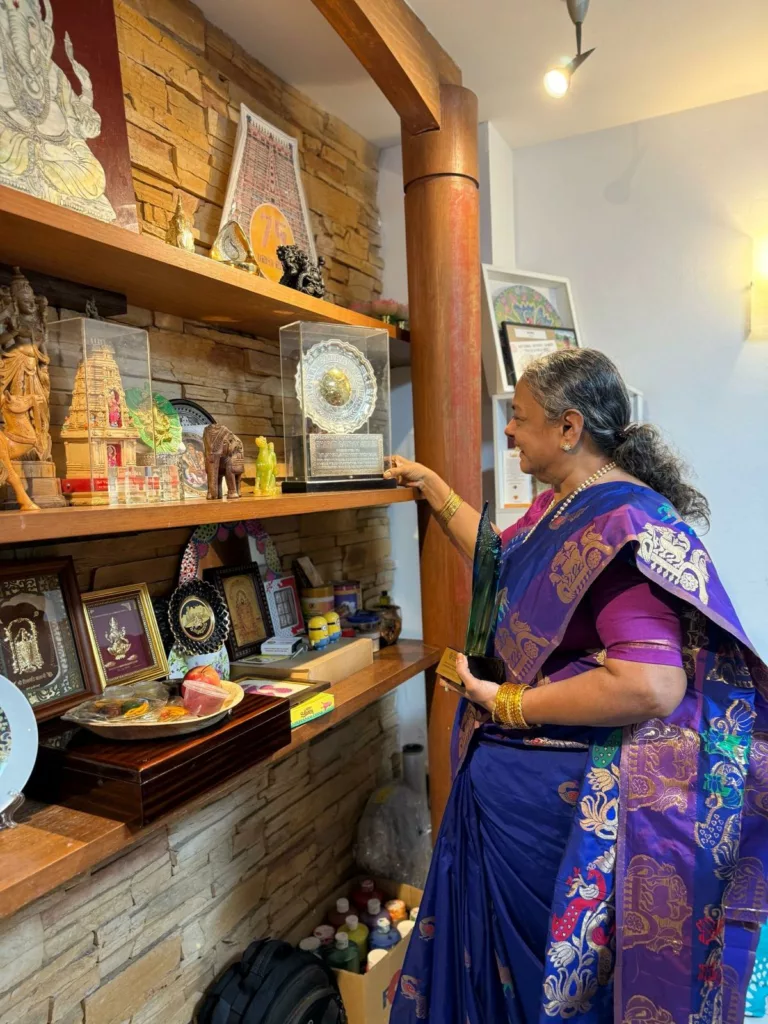
Passion for creation that took hold early in life
Vijayalakshmi, who grew up in Srirangam, a small town in southern India, saw her mother wake up early in the morning and start drawing kolam designs. Little Vijayalakshmi was handed a small amount of rice flour and was allowed to help her mother complete the kolam. The child was a natural and picked up the technique very quickly; indeed, on some days when she could not make a kolam with her mother, the little girl cried.
Besides kolam, mother and daughter created rangoli designs, too. “Every December, like before Pongal, Margazhi month, from December 15th to January 15th, we would get up at 2 o’clock in the morning and we would fill up the whole courtyard with the colourful designs,” says Vijayalakshmi of those early days in India.
Passionate about kolam and rangoli, the young Vijayalakshmi possessed a book that had more than a thousand designs in it, but one of the floods that hit southern India swept away this book, along with many other belongings. Nonetheless, the knowledge she held in her mind could never be destroyed, and now she imparts it to others, making her a truly worthy steward of this intangible cultural heritage.
This art of rangoli (or kolam or alpana) is not random; there is a science behind it — despite the seemingly effortless way the design expands in the hands of the artist, it takes mental calculations to maintain the symmetry and to hold the entire finished piece together, depending on the space available for the design.
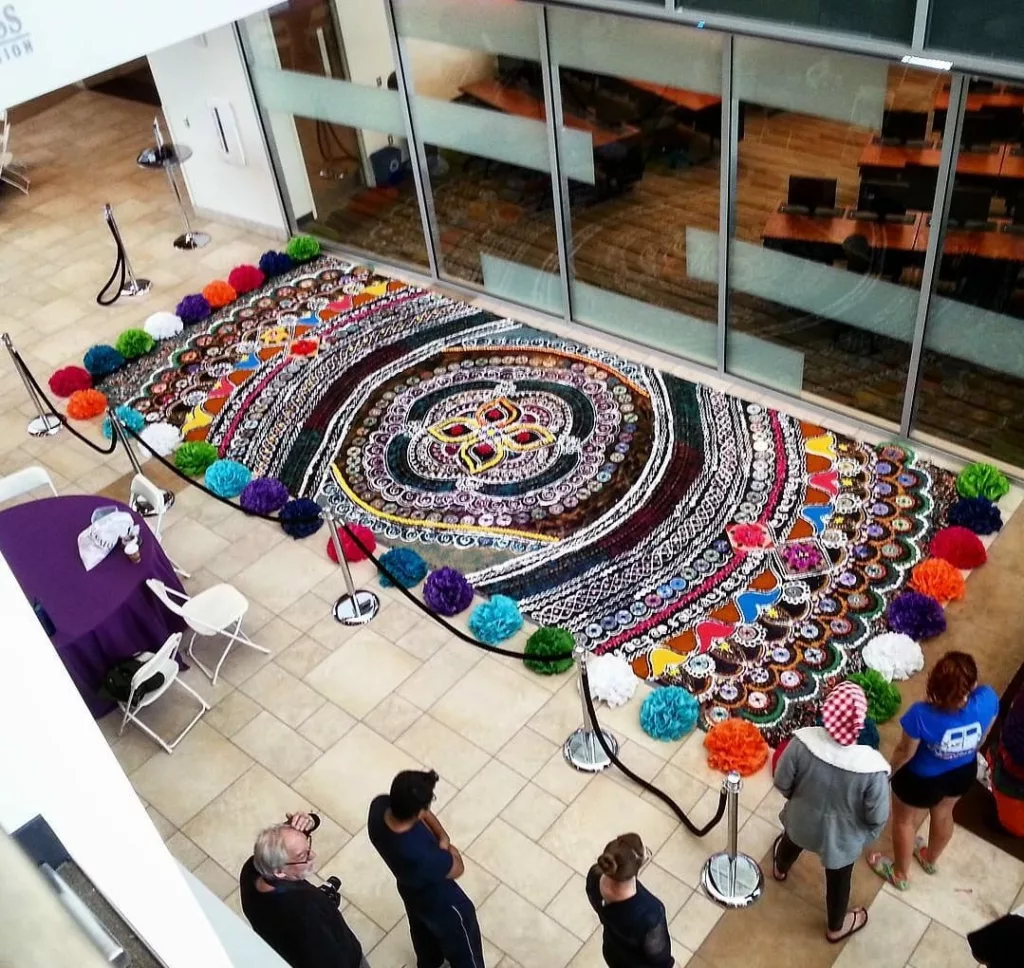
“Whenever I create a rangoli, what I do is, I look at where I am going to draw [the design], what kind of people are going to see it and how — everything I calculate. And then I just decide upon the design on the spot, according to the space and according to the state of my mind, because professionally, I’m an art therapist now,” she tells us.
Arrival in Singapore and first rangoli creation
An accomplished kolam/rangoli artist long before she moved to Singapore — she and her two children (who were in Mumbai), her husband (who was in Saudi Arabia), and her brother (who was in Singapore) all decided to live in the same city — Vijayalakshmi found an avenue for her talent soon after her arrival in the island nation, in 1992.
Vijayalakshmi’s first rangoli in Singapore — a Ganesha image made in an open space for a competition in 1993 — was literally gone with the wind, as a stiff breeze blew away all the coloured powder. She did not win the competition, but she did understand her new country and how her art would have to adapt.
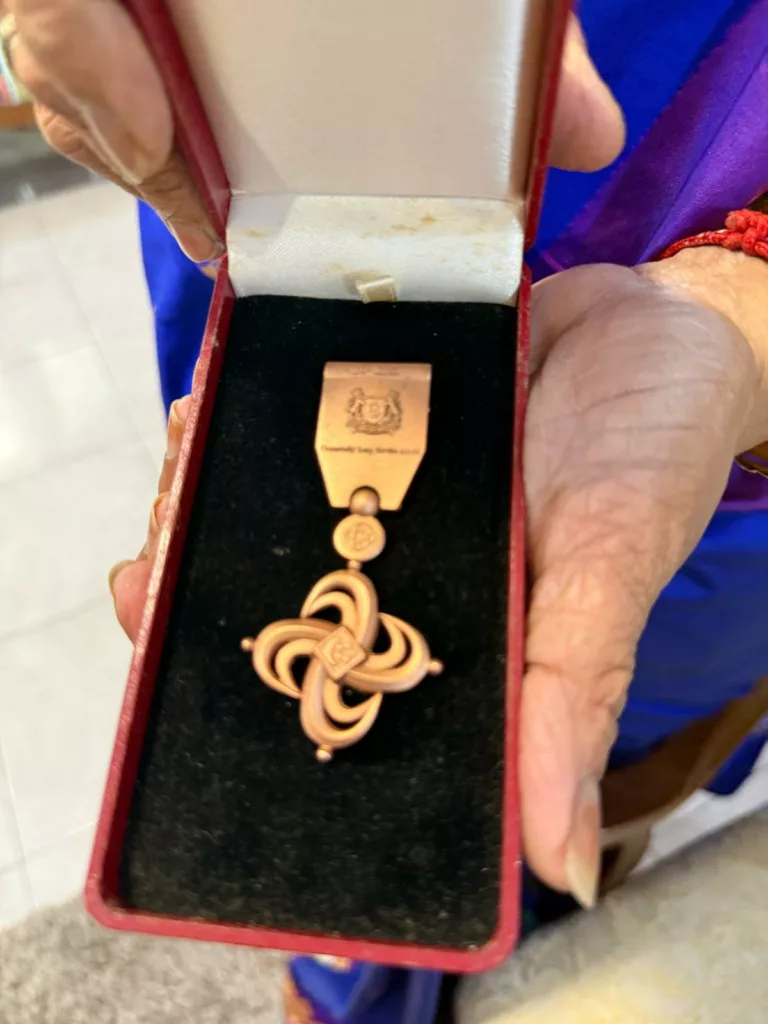
“Here [in Singapore], I noticed that people didn’t know how to draw traditionally. Very few were doing kolam and rangoli. They drew with chalk and then filled in the colours,” she says. “So, I thought, ‘Why don’t I teach people, why don’t I expose this art to more people so that they can learn?’”
Describing the position of the bent head while creating a rangoli as “chin mudra”, Vijayalakshmi calls it a “kind of meditation”, something akin to yoga, with a beneficial effect on the brain.
She got a job in Singapore, but gave her spare time to teaching rangoli and conducting weekend workshops. These were part of an art exposure programme launched by the Singapore Government in 1997.
At the age of 48, she got her Master’s degree (2006-2007) in Art Therapy. From here on, rangoli became an instrument not just of artistic expression but also of therapeutic application.
“I started [teaching] rangoli as a therapy in hospitals, old-age homes, children’s homes, mental hospitals, everywhere…I observed how they used the materials and created the patterns,” says Vijayalakshmi.
SingaRangoli, a platform for reinventing a tradition
These art therapy sessions led to SingaRangoli, a platform for rangoli art founded by Vijayalakshmi with the support of her husband, N Mohan.
This platform was built on a solid reputation earned in Singapore by Vijayalakshmi. “In 1995, the Ritz-Carlton hotel told me, ‘You have to give us a rangoli, but it should not spoil our carpet.’ So I started pasting everything,” says the artist.
About a decade later, in 2005, “I made the first all-weather rangoli in the world”, she tells us. “It was outside, in rain and shine, for more than a month.”
This pioneering creation was a family endeavour — Vijayalakshmi’s husband was a “glue specialist” who created a special adhesive and helped her transition to making all-weather rangolis.
“During COVID [pandemic], I made a rangoli with 100,000 newspapers, and it was out in the open for more than six months,” she says.
Ever methodical, Vijayalakshmi first makes a base layer of adhesive on which the all-weather rangoli would be designed; then she creates the rangoli pattern with the powders; and finally, she seals in the artwork with a top coat of adhesive, a sort of ‘varnish’ that would protect the design in any kind of weather.
“Nobody else [in the world] is doing all-weather rangoli,” says Vijayalakshmi of her unique art. Like a scientist testing theories through experiments, she tests her all-weather rangolis by creating mini-patches of the design and subjecting them to water and sunrays, examining how long the design can last under different conditions.
Vijayalakshmi’s spirit of innovation encompasses not just how a rangoli is made, but also what it is made with. SingaRangoli works with a lot of non-Indians, some of whom are allergic to coloured powder or have trouble bending down on the floor, so she has taught them to create rangoli art with recycled/upcycled materials, such as 50,000 bangles, 6,000 spoons, 20,000 cotton earbuds, 20,000 small mirrors, and even 65,000 old CDs. With these materials, the learners can sit at a table and make “traditional designs with contemporary materials”.
The name “SingaRangoli”, therefore, signifies the “Singapore version of rangoli”, says the founder.
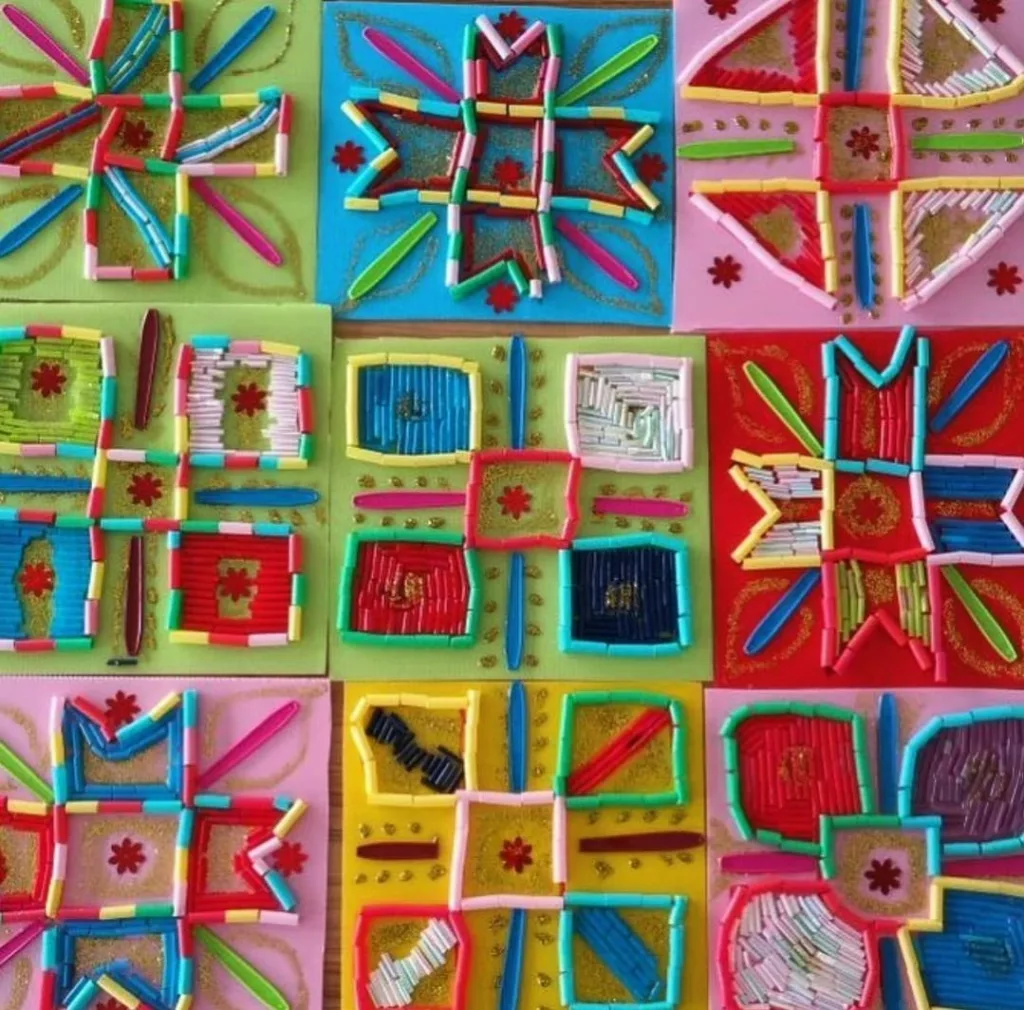
Rangoli has benefits for the mind and the body
Singapore helped her discover the art therapy aspect of rangoli, but even before that, Vijayalakshmi knew about the positive impact of rangoli/kolam art on the mind and the body. In a video posted on Instagram, she says, “Whenever I am sick, I’ll just create a [rangoli] design. It gives me energy. At the same time, colours and the design give me a lot of happiness. And then I forget that I am very sick.”
Her Guinness record-making rangoli at Whampoa Community Centre in Singapore came after several major surgeries. In 2008, she worked for seven hours — bent over the ground from 7am to 2pm — to create this rangoli that measured 2,756 square feet in size (52’ x 53’). Encouraged by gathered onlookers, including Singapore minister Heng Chee How, she finished her rangoli, braving all discomfort and achieving her heart’s desire. “It was a very memorable and touching moment,” says Vijayalakshmi. “When I finished, they all clapped and cheered.”
Making a rangoli gives one a lot of mental wellness, emotional wellness, self-care, so many things are there. See, actually why we do rangoli in front of the doorstep, [it is] because people enter your house with different kinds of emotions. When they see that symmetrical design, it changes your mind immediately. So, you bring positive energy into the house; that is the underlying factor.
Vijayalakshmi Mohan, rangoli and kolam artist and art therapist

The Indian culture of a woman in a traditional household making a rangoli or a kolam early in the morning has health benefits, she tells Connected to India. How so? Vijayalakshmi explains, “When you get up early in the morning and do the rangoli, the oxygen level in the air is very high. So, when you bend and do [the rangoli], it is a kind of yoga. The oxygen goes to your brain very fast. The lady of the house needs a lot of energy to look after so many things in the house in the morning, in the rush.”
Alluding to the practice of making a kolam in a traditional open courtyard, she adds, “When you create this small kolam or rangoli outside the house, it gives [you] a lot of energy, problem-solving ability, and it helps you analyse what to do first, what to do next, everything. And then you can work immediately. These are all the underlying things we have.”
Making a rangoli stimulates the senses, feels the artist and art therapist — touching the coloured powders or other materials; looking at the bright colours; inhaling the fragrance of the flowers used in a rangoli. This is like “colour meditation”, she says.
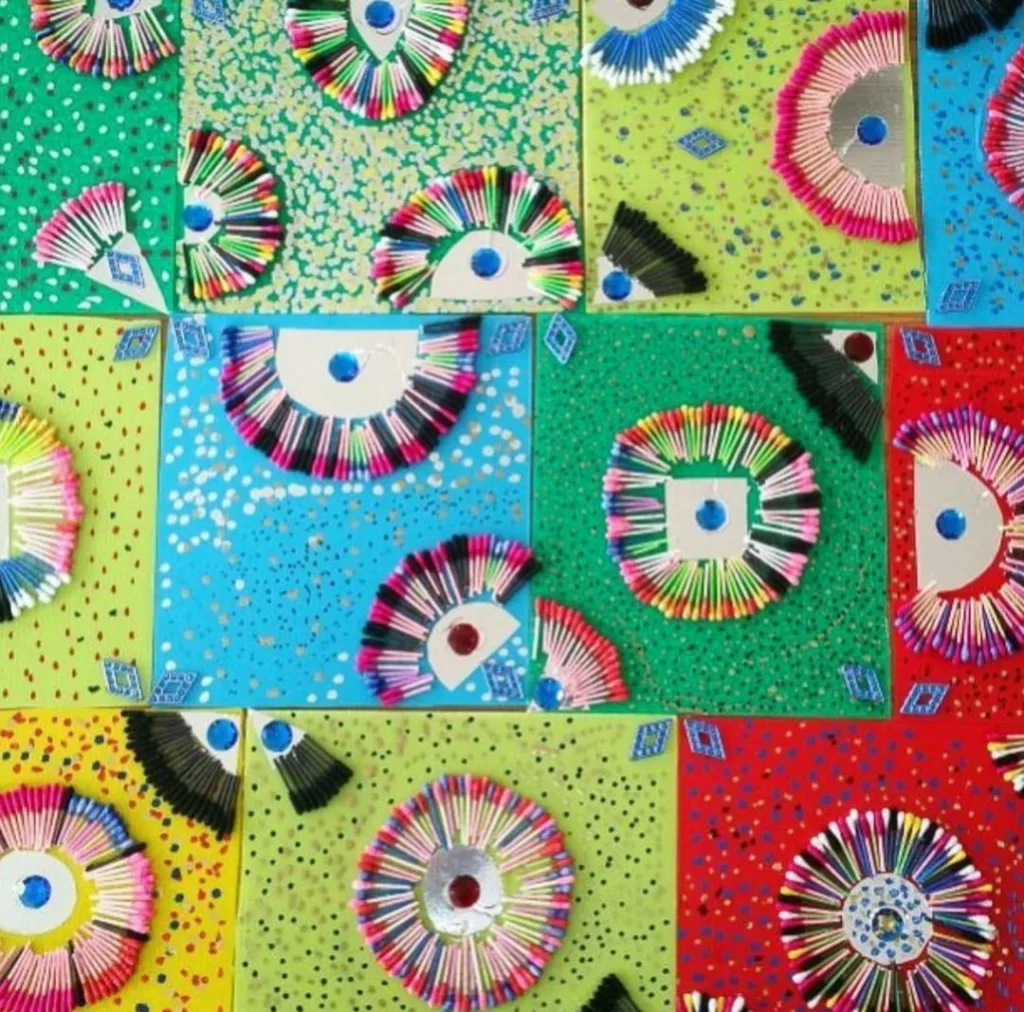
These elemental benefits of rangoli creation may be lost on today’s gizmo-crazy youngsters, for whom the sense of touch mostly comes from tapping on a smart screen. However, her keenness to push the boundaries of rangoli art has given Vijayalakshmi an idea of how to interest the youth.
Vigorously embracing new concepts, she came up with the “dancing rangoli” in 2021. This combination of rangoli and iPad technology led to a programme that would make a rangoli appear on a screen while the iPad user danced to some music. This interactive programme allowed users to insert their choice of colours into the rangoli pattern through a smart app.
Next on Vijayalakshmi’s mind is the use of AR (augmented reality) and VR (virtual reality) in rangoli art. Unfettered by the rigidity of tradition, this steward of intangible heritage is helping the rangoli evolve for each new generation.

